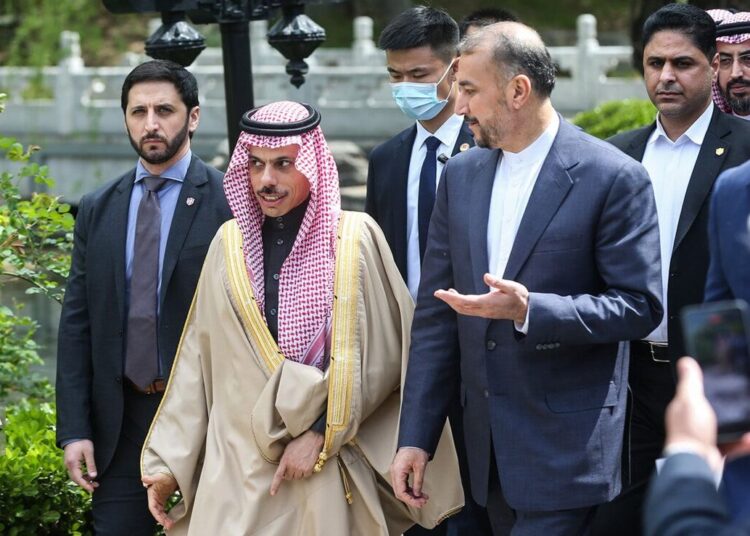As if in a carefully choreographed dance, Iran and Saudi Arabia are reciprocating diplomatic overtures, advancing from reconciliation to forging deeper, more congenial cooperation. Viewed through this lens, the recent sojourn of Iran’s Foreign Minister, Hossein Amirabdollahian to Saudi Arabia signifies yet another milestone in the strengthening of Tehran-Riyadh ties, no less a robust riposte to Faisal bin Farhan’s trip of June 17. This pivotal visit heralds a rejuvenating chapter in the ongoing dialogue between Iran and Saudi Arabia aimed at enhancing bilateral relations, said Iranian and Saudi foreign minister in a joint press conference subsequent to their meeting today in Riyadh.
Discussions of rekindling diplomatic ties have matured and now the focal point of the Riyadh dialogues is the conceptualization of a roadmap engineered to expand and amplify bilateral ties. The bid for a redefined bilateral policy – constructed meticulously through joint and multi-faceted cooperation and by reshaping regional rivalry into regional collaboration – continues unabated. This trajectory lays the groundwork for renewed optimism regarding further Iran-Saudi cooperation.
Strengthening the ties
The liberal perspective contends no pair of democratic governments wage war on each other. Similarly, Tehran and Riyadh manipulate this axiom intent on elucidating why two Islamic governments should ever find reason to conflict. Indeed, inherent, intrinsic ties closely bind Islamic nations in an incontrovertible bond. While skeptics continue to speculate on the evolution of relations between Iran and Saudi Arabia, trapped under the specter of religious disparity, both countries are resolute, demonstrating a fresh perspective focusing on shared values.
Several themes have emerged through the intersections between Iran and Saudi Arabia in recent months, indicating both states’ strategic considerations toward sustainable, long-term benefits of improved relations. These include:
- Amplified focus on Islam, and the emotional, societal bonds fostering a shared vision amongst Muslims;
- Recognition of sovereignty, deterring proxy warfare;
- Exploring avenues for mutually beneficial cooperation;
- Resisting divisive schemes designed to disrupt regional equilibrium;
- Withholding participation in rivals’ media machinations and heightened stances;
Reinforcing these mutual synergies and limiting emphasis on disparities fosters deeper relationships at all societal levels and are the product of a concerted effort to enhance connections through organic bonds between the two Muslim nations.
Expanding cooperation spheres
The Saudi-Iran agreement echoes the strategic dynamics at play within Tehran and Riyadh. Driven by overlapping shared interests, and the shifting outlook of the two capitals, both countries are seeking amicable resolution of contemptuous issues to forge bilateral and regional peace. Thus, new arenas for cooperation between Iran and Saudi Arabia are surfacing, equaling the attention paid to past confrontations. The talks today pave the way for a broader cooperative sphere ranging from politics to economics to security, media, and societal matters; significantly bolstering trust-building measures.
The consensus for operationalizing communication channels, presentation of joint economic blueprints, and establishing advanced mechanisms for insulating their relations from foreign intrusion are potential negotiation pillars for Iran and Saudi Arabia. There is an anticipation of an upward trend in security dialogues which will catalyze economic cooperation, in no small measure.
Similarly, the invigoration of economic diplomacy between Iran and Saudi Arabia populates the terrain of cooperation with regard to their bilateral relations. Liaison in the energy marketplace, joint endeavors in scientific and technological domains, as well as the reciprocal exchange of capital and services stand as imperative pillars buttressing the economic ties between Iran and Saudi Arabia. Despite the reality that both nations hinge on energy exports, they boast of economies that are complementary across other domains.
Iran is poised to export its technological and engineering expertise to Saudi Arabia; in return, Saudi Arabia can funnel investments into areas that resonate with Iran’s developmental aspirations. The prospect of joint collaboration extends across a broad spectrum – industrial cooperation, healthcare services, sectors intricately tied to oil and gas, agricultural production, and food industries. The escalation of commercial relations buttressed by the private sectors of both countries assumes top priority; this mutual reinforcement also fortifies social and elite networking.
On a grander scale, Iran and Saudi Arabia can morph into crucial nodal points linking Africa, Europe, and Asia, thus establishing a rising geo-economic axis. Saudi Arabia offers Iran effortless access to Africa, while Iran reciprocally facilitates Saudi Arabia’s closer proximity to Central and East Asia. Consequently, the geo-economic linkage unveils a roster of benefits for both nations.
Regional symphony of peace
The evolution of diplomatic relations between Iran and Saudi Arabia is an imperative strategy to safely navigate through the contentious waters in the Persian Gulf and the Middle East. Notwithstanding the myriad challenges, both nations possess compelling reasons to strive for regional stability, underpinned by their respective motivations to expand and ascend into the ranks of emerging powers. The shifting global landscape, waning American influence, and the rise of new powers further motivates Tehran and Riyadh to bridge ideological gaps, diminish regional costs, and concentrate on national development. In this vein, enduring political and economic cooperation can assuage competitive concerns and bolster the national programs of the two countries.
Saudi Arabia and Iran have reached a consensus that the past four decades of conflicts have neither served their economic nor political interests, but have instead hindered their ascension as emerging global powers. In contrast, adversaries of both nations have reaped considerable benefits from the instability of their relationship.
Indeed, initial steps towards de-escalation between Tehran and Riyadh may not have prioritized regional exigencies with the exception of Yemen but they constitute an essential component of the motivations and objectives underlying the agreement. The anticipated ripple effect of bolstered bilateral relations between Iran and Saudi Arabia potentially easing regional tensions and enhancing regional stability has been warmly received by a number of regional countries.
In this context, the recommencement of diplomatic relations has steered the regional strategy of Tehran and Riyadh towards a course correction. These transformations are palpably manifested in the political dispositions of Iran and Saudi Arabia toward Iraq, Syria, Lebanon, and Yemen. In recent months, neither party has exhibited actions undermining the interests of the other. Conversely, both countries have demonstrated that multilateral relations can potentially supplant the historical protracted conflict between Tehran and Riyadh.
The tide of new regional and international developments has reoriented the relationship between Riyadh and Tehran toward a trajectory surpassing the usual confines of political and religious competition. Outcomes of fostering relations between Tehran and Riyadh encompass the reduction of regional tensions, expansion of regional economic cooperation, prevention of foreign instigators of tension, averting internal socio-economic-political crises, and a heightened focus on pressing issues pertinent to the Islamic world, including the Palestinian cause.
The shifting dynamics of the relations between Iran and Saudi Arabia signify a potential alteration in the regional power balance. The United States may persist in its efforts to foster rapprochement between Israel and Saudi Arabia through the Abraham Accords and to create distrust in the ties between Tehran and Riyadh, but these endeavors will entail intricate conditions that are not readily attainable for Washington.






